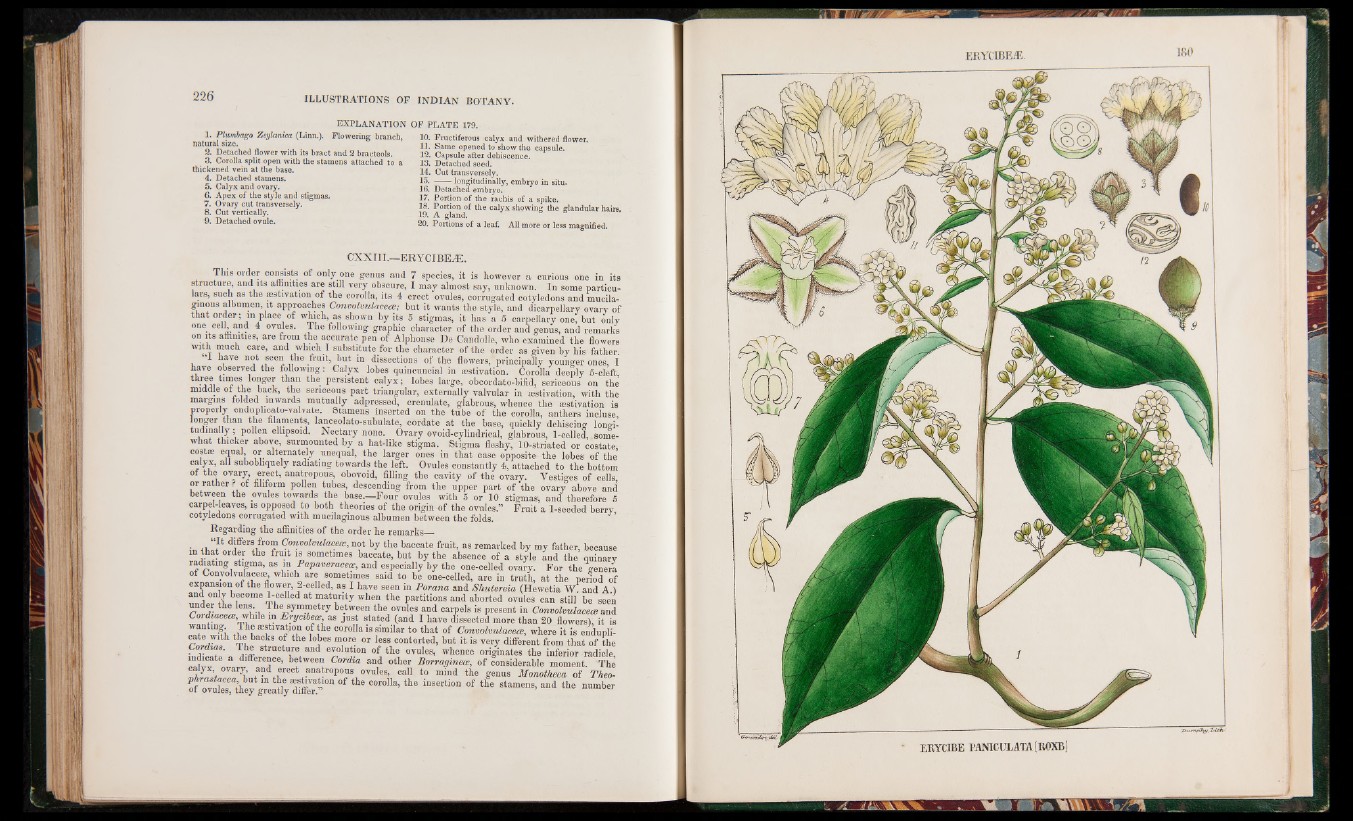
1. Plumbago Zeylanica (Linn.),
natural size.
EXPLANATION OF PLATE 179.
Flowering branch,
2. Detached flower with its bract and 2 bracteols.
3. Corolla split open with the stamens attached to a
thickened vein at the base.
4. Detached stamens.
5. Calyx and ovary.
6. Apex of the style and stigmas.
7. Ovary cut transversely.
8. Cut vertically.
9. Detached ovule.
10. Fructiferous calyx and withered flower.
11. Same opened to show the capsule.
12. Capsule after dehiscence.
13. Detached seed.
14. Cut transversely.
15. ------ longitudinally, embryo in situ.
16. Detached embryo.
17. Portion of the rachis of a spike.
18. Portion of the calyx showing the glandular hairs.
19. A gland.
20. Portions of a leaf. All more or less magnified.
CXXIII.—ERYCIBEjE .
This order consists of only one genus and 7 species, it is however a curious one in its
structure, and its affinities are still very obscure, I may almost say, unknown. In some particulars,
such as the aestivation of the corolla, its 4 erect ovules, corrugated cotyledons and mucilaginous
albumen, it approaches Convolvulacetz; but it wants the style, and dicarpellary ovary of
that order; in place of which, as shown by its 5 stigmas, it has a 5 carpellary one, but only
one cell, and 4 ovules. The following graphic character of the order and genus, and remarks
on its affinities, are from the accurate pen of Alphonse De Candolle, who examined-the flowers
with much care, and which I substitute for the character of the order as given by his father.
‘I have not seen the fruit, but in dissections of the flowers,"principally younger ones, I
have observed the following: Calyx lobes quincuncial in aestivation. Corolla deeply 5-cleft
three fames longer than the persistent calyx; lobes large, obcordato-bifid, sericeous on the
middle of the back, the sericeous part triangular, externally valvular in estivation, with the
margins folded inwards mutually adpressed, crenulate, glabrous, whence the estivation is
properly enduplicalo-valvate. Stamens inserted on the tube of the corolla, anthers incluse,
longer than the filaments, lanceolato-subulate, "cordate at the base, quickly dehiscing longi-
tudmally; pollen ellipsoid. Nectary none. Ovary ovoid-cylindrical, glabrous, 1-celled, somewhat
thicker above, surmounted by a hat-like stigma. Stigma fleshy, 10-striated or costate,
costae equal, or alternately unequal, the larger ones in that case opposite the lobes of the
calyx, all subobliquely radiating towards the left. Ovules constantly 4, attached to the bottom
ot the ovary, erect, anatropous, obovoid, filling the cavity of the ovary. Vestiges of cells,
or rather ? of filiform pollen tubes, descending from the upper part of the ovary above and
between the ovules towards the base.—Four ovules with 5 or 10 stigmas, and therefore 5
carpel-leaves, is opposed to both theories of the origin-of the ovules.” Fruit a 1-seeded berry
cotyledons corrugated with mucilaginous albumen between the folds. ’
Regarding the affinities of the order he remarks—
• iw * I S m l Cnny olvulac!lce^ not by the baccate fruit, as remarked by my father, because
in that order the fruit is sometimes baccate, but by the absence of a style and the quinary
radiating stigma, as m Papaveracece, and especially by the one-celled ovary. For the genera
of Convolvulacese, which are sometimes said to be one-celled, are in truth, at the period of
expansion of the flower, 2-celled, as I have seen in Parana and Shutereia (Hewetia Wiand A.)
and only become 1-celled at maturity when the partitions and aborted ovules can still be seen
The symmetry between the ovules and carpels is present in Conmlvulaceaand
C ordiacetz, While m Erycibew, as just stated (and I have dissected more than 20 flowers), it is
wanting. The aestivation of the corolla is similar to that of Convolvulacece, where it is endupli-
r w - tv. , “ A the lo,bes m,ore. or less contorted, but it is very different from that of the
huvfoTit' ■> Trff 8trncture and evolution of the ovules, whence originates the inferior radicle,
indicate a difference, between Cordia and other Borraginece, of considerable moment. The
calyx, ovary, and erect anatropous ovules, call to mind the genus Monotheca of Theo-
phrastacea, but in the estivation of the corolla, the insertion of the stamens, and the number
ot ovules, they greatly differ. ™
wwfÊPrÆ.
ERYCIBEÆ.